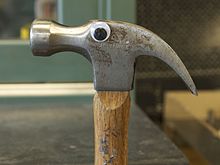This is an old revision of this page, as edited by Dostreetart (talk | contribs) at 15:13, 22 October 2022 (→History: https://www.youtube.com/watch?v=0OJQdjiHXcU). The present address (URL) is a permanent link to this revision, which may differ significantly from the current revision.
Revision as of 15:13, 22 October 2022 by Dostreetart (talk | contribs) (→History: https://www.youtube.com/watch?v=0OJQdjiHXcU)(diff) ← Previous revision | Latest revision (diff) | Newer revision → (diff) Small plastic circles imitating eyes For the medical eye condition sometimes known as googly eye, see Strabismus. For the American singer who performed as "Mr. Google Eyes", see Joe August (musician).

Googly eyes, or wiggle eyes, are small plastic crafting items used to imitate eyeballs. Googly eyes traditionally are composed of a white plastic or card backing covered by a clear, hard-plastic shell, encapsulating a black plastic disk. The combination of a black circle over a white disk mimics the appearance of the sclera and pupil of the eye to humorous effect. The inner black disk is allowed to move freely within the larger clear plastic shell, which makes the eyes appear to move when the googly eyes are tilted or shaken.
The plastic shells come in a variety of sizes ranging from 3⁄16 inch (4.8 mm) to over 24 inches (610 mm) diameter. The inner disks come in a variety of colors including pink, blue, yellow, red and green. Googly eyes are used for a variety of arts and crafts projects including pipe cleaner farm animals, silly sock puppets, mischievous pranks, and other creations. Googly eyes may also be attached to inanimate objects in order to give the objects a "silly" or "cute" appearance. This use often personifies the objects for a humorous effect, or to make an object less threatening and more appealing.
History

The name "googly eyes" may refer back to the early 20th century comic strip Barney Google and Snuffy Smith, in which Barney Google had characteristically exaggerated eyes that inspired a hit 1923 song "Barney Google (with the Goo-Goo-Googly Eyes)".
In the 1970s, Tom Blundell, an executive of the toy company BIPO, created the hit knickknack Weepul when he began playing around with the plastic, kinetic eyes.
They were prominently used in the Weepul promotional toys, invented by someone at a toy company who stuck googly eyes to a small pom-pom out of boredom. The inventor claimed that 400 million were sold between 1971 and 2012. Similar toys have appeared since then, like the "Wuppies", a toy which was popular in the Netherlands in the 1980s, and the "Pirilampo Mágico" ("Magic Firefly"), a popular toy sold annually in Portugal since 1987 as a fundraising product for CERCI, a co-op specialized in helping the mentally disabled. Recent iterations of this toy have replaced its googly eyes and pom-pom appearance for one made fully in plastic.
Beginning in the 2000s, a trend called "eyebombing" emerged of sticking googly eyes to objects in the urban environment. The inspiration for the movement has been claimed by French artist Do Benracassa, in his 1980s project "Ça Vous Regarde".https://medium.com/@nixiep/the-origins-of-eyebombing-3203d18da5d9 Nixie P, "The Origins of Eyebombing", Medium.com. more ...A report from France 3, a French TV channel, proves the anteriority of the eyebombing concept, this report where the artist Do Benracassa explains his cencept dates from 1997! . Here is the link: https://www.youtube.com/watch?v=0OJQdjiHXcU 1 April 2020]. Retrieved 6 May 2021</ref> It was then developed by two unnamed Danish artists, and a group called the Googly Eyes Foundation emerged to spread the phenomenon.
The Guinness World Records recognises a pair of googly eyes measuring 12 feet (3.7 m) in diameter made in 2019 as the largest ever.
In popular culture
Googly eyes are featured in the 2022 film Everything Everywhere All at Once and its promotional materials.
See also
- Googly eyed doll
- OOglies
- Pareidolia, tendency to see faces in inanimate objects, among other perceptions
References
- ^ Gotthardt, Alexxa (2 October 2018). "How Googly Eyes Became an Essential Part of Crafts". Artsy.net. Retrieved 21 April 2021.
- Corkery, Michael (26 February 2020). "Should Robots Have a Face?". The New York Times. Retrieved 21 April 2021.
- Tarantola, Andrew (22 May 2019). "Why putting googly eyes on robots makes them inherently less threatening". Engadget. Retrieved 21 April 2021.
- Grundhauser, Eric (13 January 2017). "Rediscovering the Wonderful World of Weepuls". Atlas Obscura. Retrieved 21 April 2021.
- "Pirilampo Mágico - FENACERCI". FENACERCI. Retrieved 22 May 2022.
- ""Pirilampo Mágico" iterations - FENACERCI". FENACERCI. Retrieved 22 May 2022.
- "Eyebombing: Using goggly eyes to bring objects to life". 20 December 2013. Retrieved 21 April 2021.
- Martinez-Conde, Susana; Macknik, Stephen L. (1 May 2020). "Eyebomb Your Brain". Scientific American. Retrieved 21 April 2021.
- Barnes, Sara (3 June 2017). "People Are Sticking Googly Eyes on Ordinary Street Objects Around the World". My Modern Met.
- "Largest pair of googly eyes". Guinness World Records. Retrieved 21 April 2021.
- Flower, Amy (December 15, 2021). "Whoa! Everything Everywhere All At Once looks bonkers!". stack.com.au. STACK magazine. Retrieved 19 December 2021.
- Booth, Kaitlyn (December 15, 2021). "Everything Everywhere All At Once: First Image, Trailer, and Poster". bleedingcool.com. Bleeding Cool. Retrieved 19 December 2021.